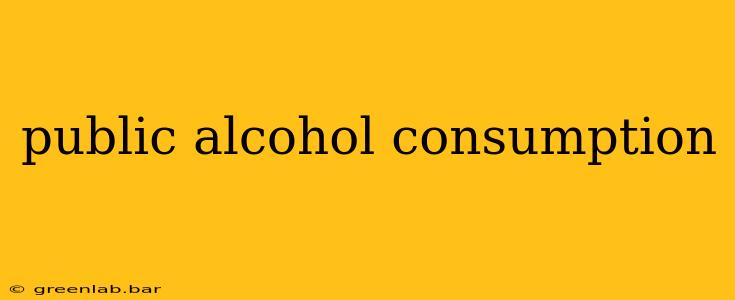Public alcohol consumption is a complex issue with varying legal ramifications and significant social implications. This comprehensive guide explores the laws surrounding public drinking, the associated risks, and how to practice responsible alcohol consumption in public spaces.
Laws Regarding Public Alcohol Consumption: A Patchwork of Regulations
The legality of public alcohol consumption varies dramatically depending on location. There's no single, nationwide standard in many countries, including the United States. Laws differ significantly between states, counties, and even municipalities. Some areas may have outright prohibitions, while others permit alcohol consumption in designated public spaces or under specific conditions. These conditions might include:
- Designated outdoor refreshment areas (DORAs): Many cities now have designated areas where open container laws are relaxed, often promoting local businesses and tourism.
- Special events: Permits often allow alcohol consumption at festivals, concerts, and other public gatherings.
- Parks and beaches: Regulations vary widely. Some parks may completely prohibit alcohol, while others might allow it in specific areas or at certain times.
Before consuming alcohol in public, always check local ordinances. Ignoring these laws can lead to fines, arrests, and even more serious consequences. Resources like local government websites or law enforcement agencies provide the most accurate and up-to-date information.
The Risks of Public Drinking: Beyond Legal Penalties
Beyond the legal repercussions, public alcohol consumption poses several risks:
Health Risks:
- Heatstroke: Dehydration from alcohol consumption is exacerbated by hot weather, increasing the risk of heatstroke.
- Alcohol poisoning: Excessive drinking in any setting is dangerous, and public settings may lack immediate access to medical assistance.
- Increased vulnerability: Impaired judgment from alcohol can make individuals more susceptible to accidents, assaults, and other dangers.
Social Risks:
- Public nuisance: Loud or disruptive behavior stemming from alcohol consumption can negatively impact the community.
- Increased crime rates: Studies have linked public intoxication to increased incidents of violence and property damage.
- Negative perceptions: Public drinking can create negative perceptions about individuals and potentially damage reputations.
Responsible Alcohol Consumption in Public: A Guide to Safe Practices
Responsible alcohol consumption, even in designated areas, is crucial. Consider these guidelines:
- Know your limits: Avoid excessive drinking to prevent negative consequences.
- Stay hydrated: Drink plenty of water throughout the day, especially in warm weather.
- Eat before and while drinking: Food helps slow alcohol absorption.
- Designate a driver or use alternative transportation: Never drink and drive. Utilize ride-sharing services or public transportation.
- Be mindful of your surroundings and behavior: Respect others and avoid disruptive behavior.
- Consume alcohol responsibly with friends: Avoid drinking alone and always be aware of your companions.
- Pace yourself: Avoid drinking too quickly.
Conclusion: Balancing Enjoyment with Responsibility
Public alcohol consumption presents a delicate balance between individual enjoyment and community well-being. By understanding the applicable laws, acknowledging the risks, and prioritizing responsible practices, individuals can contribute to safer and more enjoyable public spaces for everyone. Remember, responsible consumption isn't just about avoiding legal trouble; it's about ensuring the safety and well-being of yourself and others. Always check local regulations and prioritize safety.

